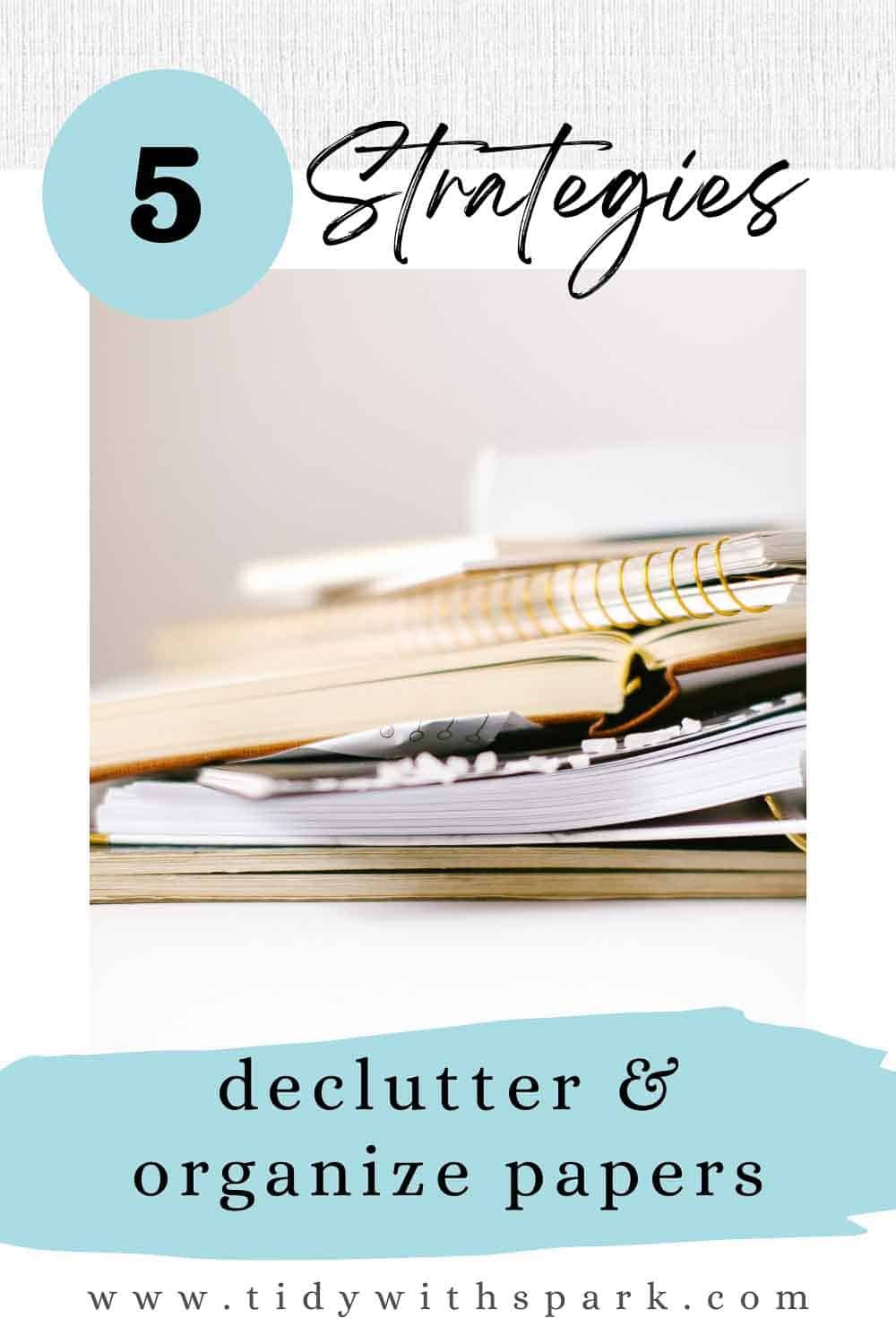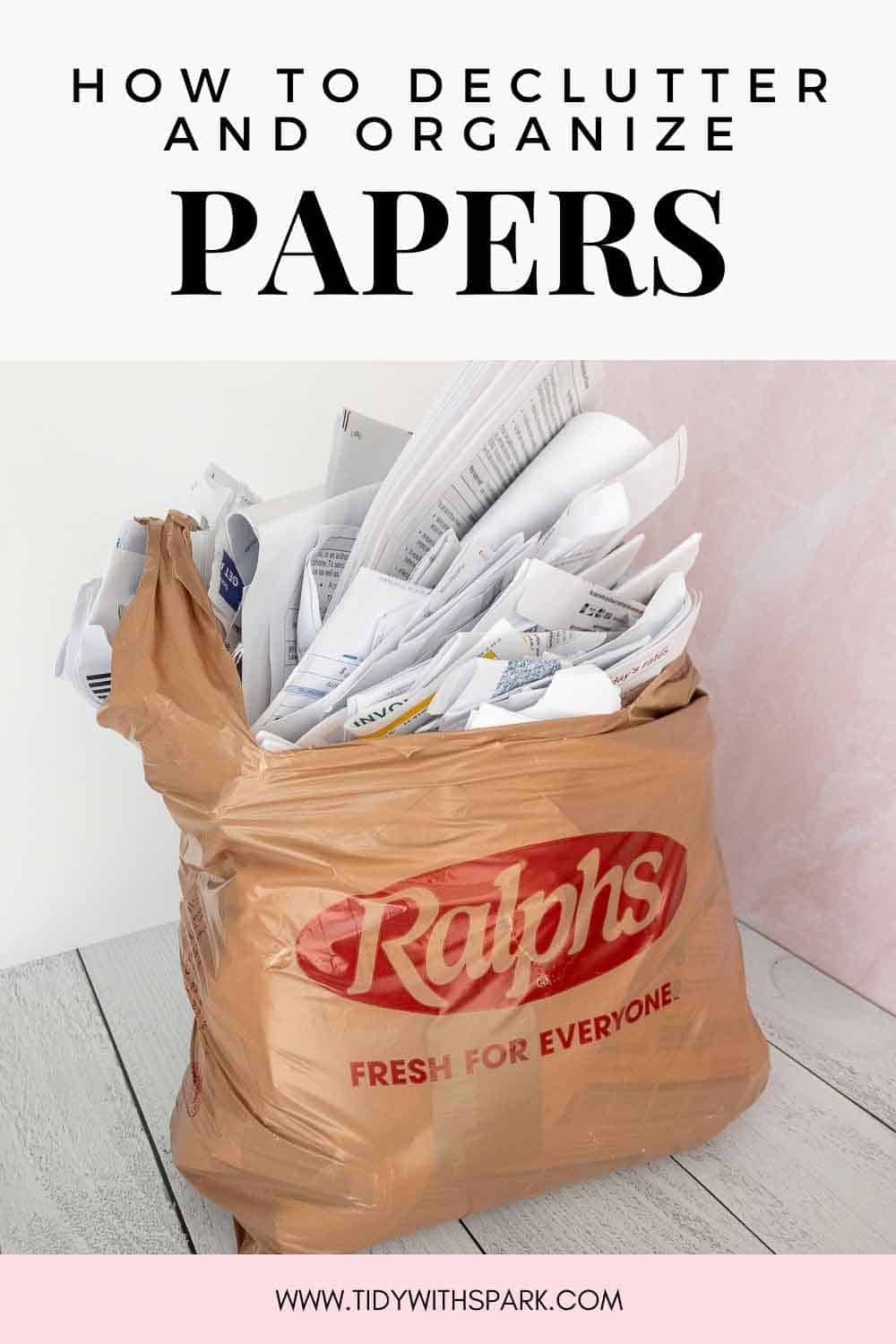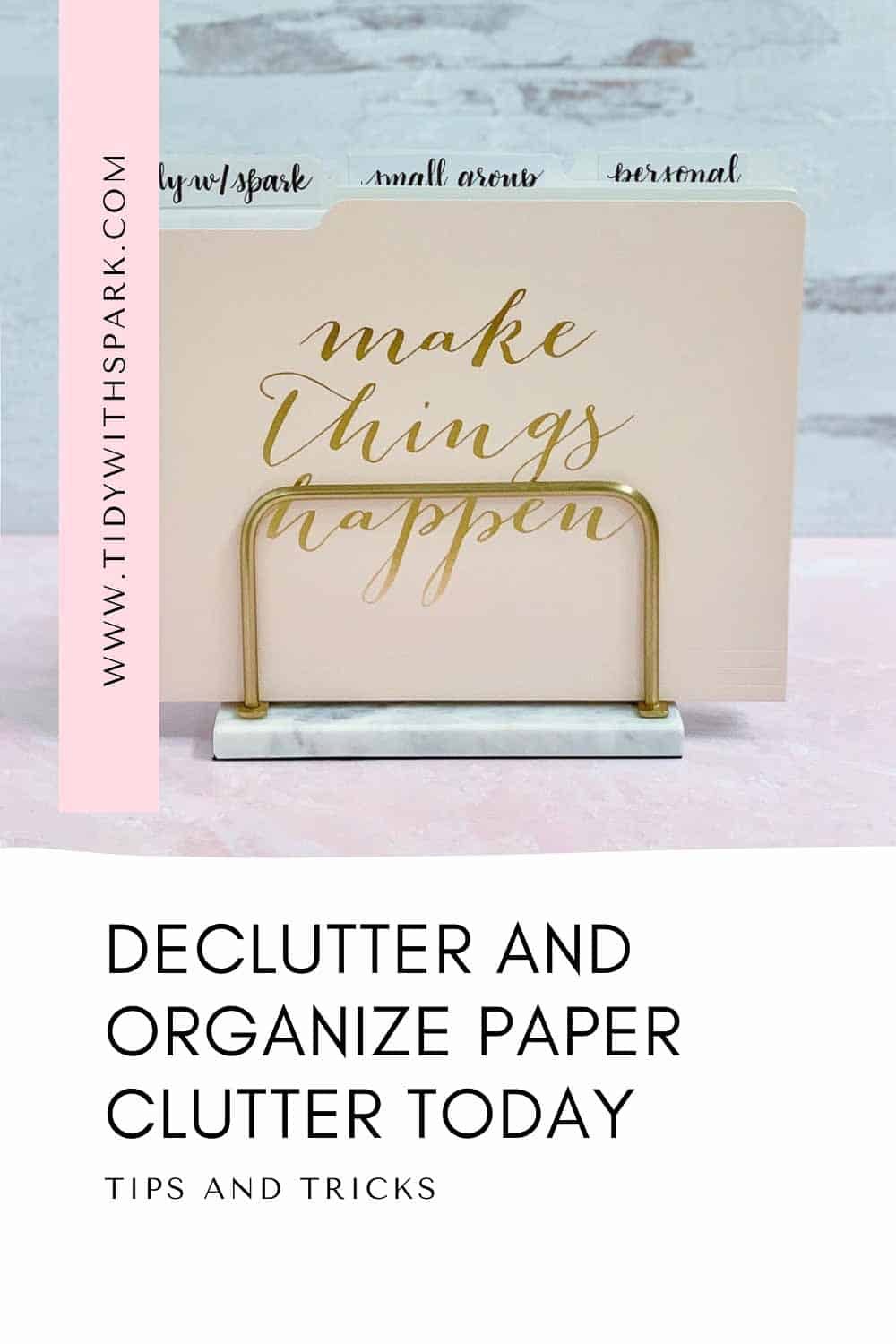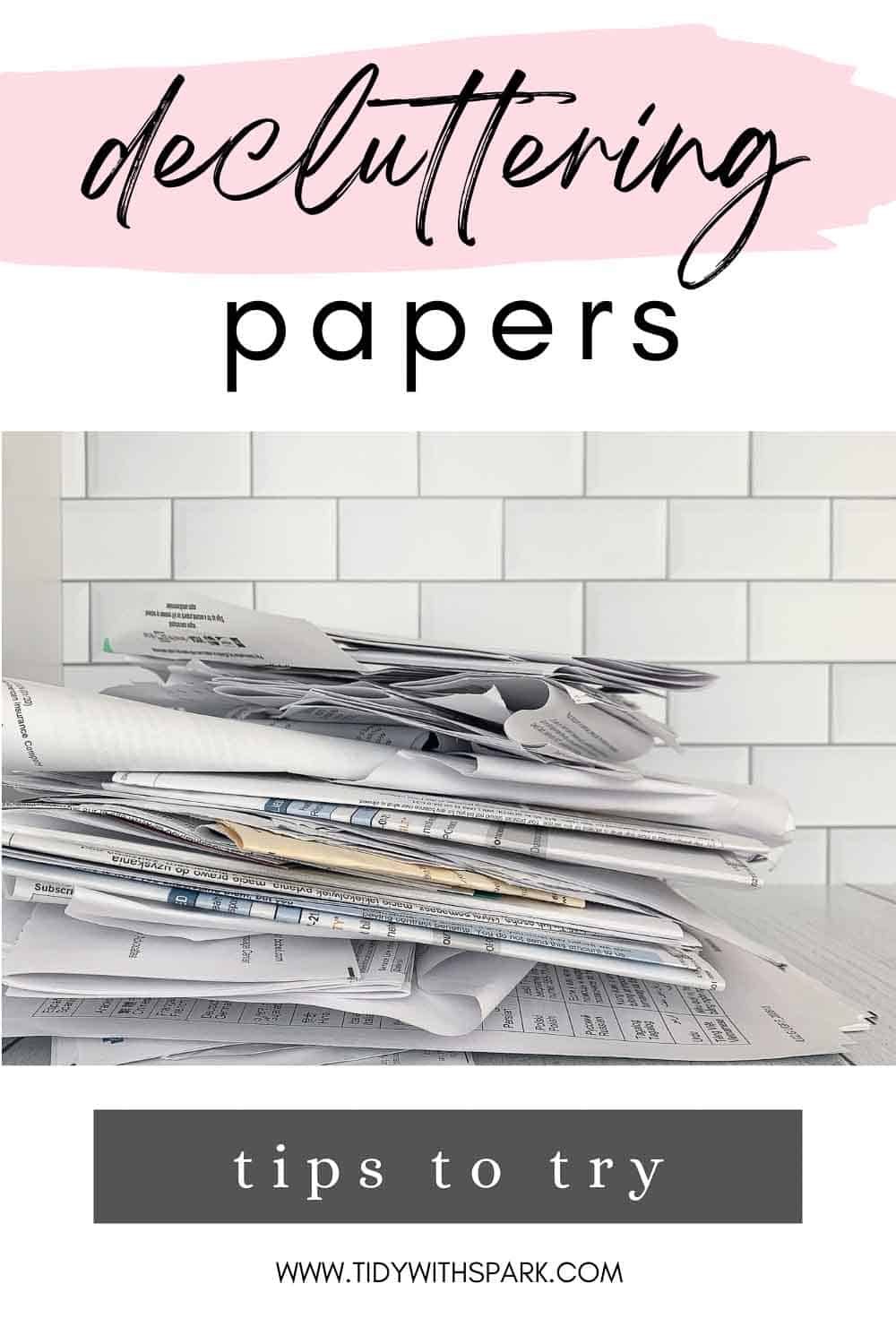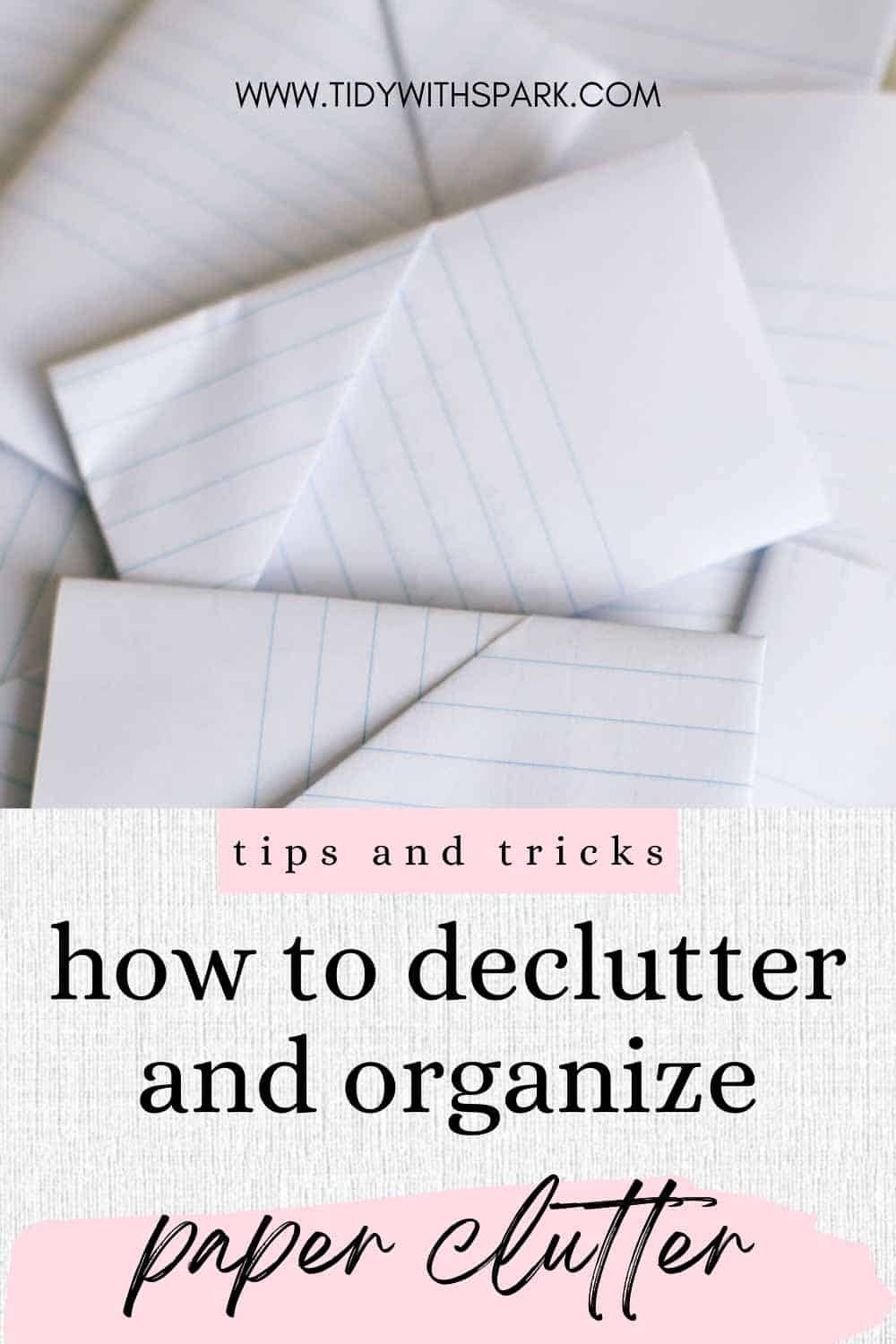How to Declutter and Organize Papers
Wondering how to organize lots of papers? This post is for you because I’m sharing all my tips on how to tackle the dreaded yet necessary task of how to declutter and organize papers once and for all. I will cover what is the best way to organize papers and share ways to maintain all your hard work over time.
Addressing our paper piles can be a daunting task because it’s so deceptive. Each sheet of paper seems harmless, but when stacked one on top of the other, you see that a one-inch pile can actually represent hundreds of action items.
That’s why I encourage all my clients to tackle papers before they even reach the inside of our homes. I often call my students the “gatekeeper”.
You are also the gatekeeper of what comes in and what goes out of your home. Take ownership of this title and role because it’s serious business especially if you want to live in a clutter free space.
Address papers before they enter your home
There are a few different ways to actively prevent papers from entering our homes. Make sure your home address is on the do not mail list.
Head to the Federal Trade Commission website and for a nominal fee you can prevent marketing materials to be sent to your home for up to 10 years. $2 is a bargain if that means you stop papers before they become a problem in your life.
If you want to opt out of insurance and credit card offers head to optoutprescreen.com to be taken temporarily (up to five years) or permanently taken off the list.
There are alternative sites that provide the same service such as Paper Karma which is tied to a very large database of thousands of verified mailers, and DMAChoice.org.
Actively monitoring papers on the front end before it becomes a problem will aid you in the process of maintaining your paper clutter.
Commit to addressing the papers
There is simply no way around this one, but you must commit to the process of decluttering your papers. A solid commitment is essential because in the process of decluttering it will always get worse before it gets better and without your actions and a defined commitment the chance of clearing the clutter is low.
If this means you need help with accountability, reach out and ask for the necessary help by asking a friend or a seasoned organization professional to help you see your commitment through.
Create three stacks of papers
After gathering all the papers in your home, you will want to group them into three distinct piles as listed below:
- Permanent paper items
- Paper action items
- Papers to discard
To help with this effort, I recommend using some storage boxes lying around or you can get some banker boxes that are well worth the investment. Simply label each box to correspond to each pile noted below.
Permanent paper items
The first pile is reserved for permanent items that should never be discarded. These are important documents such as a birth certificate or the title to your car. You likely will never get rid of these items (unless you sell your car) so it’s safe to keep these papers in the permanent pile.
Paper Action items
Paper that fall into the action item pile are papers that require some action on your part. The action can be as simple as read the document, but if it requires you to take some form of action, it is separated into this pile.
A little warning here.
If you haven’t ever looked at your credit card statement or your bank account statement, do not use this time to put these papers in the action items pile.
Be honest with yourself and realize that in this day and age, the statements are accessible online when and IF you ever plan on reconciling your accounts.
Do not get stuck here because it’s a trap.
Let the idea of reconciling your statement go because your past history is evidence of how you view this task.
After you compile all the action items, refer back to your commitment and designate a time to go through the papers to take action.
If the thought of doing this is so boring, try setting a short timer such as 5 or 10 minutes or engage in help from a friend or a professional.
Take a break and return to the task at a later time. If at the end of the timer you got into a groove and can continue, by all means, continue the task.
Papers to discard
Most client’s homes will have the discard pile be the largest because in truth, there are very few papers that are permanent and require your attention for action.
The discard pile will be all the papers that aren’t in the other two piles. This could be random receipts for consumables such as the receipt for your coffee drink from a year ago.
I see this often and having that piece of paper lying around will not serve you especially if you’re in the camp where you don’t reconcile your banking accounts on a monthly basis.
Feel free to discard the papers and release with it the guilt you have associated with the papers.
Let go of what you think you “should” have done with those papers.
While you’re discarding the papers, discard the “shoulds” too. Neither will serve you.
Invest in a heavy-duty paper shredder
One of the best pieces of advice I have ever received is have the right tools in your life to make living your life simpler.
There is no better advice than this especially when it comes to shredding your papers.
I once came across a client that insisted on cutting up her papers with a hand-held pair of scissors.
This is not something I recommended, rather I highly encourage clients to invest in a heavy-duty cross cut paper shredder to shred any documents that may have the slightest bit of confidential information on the face of the document.
Data privacy and safety is an utmost concern so take the necessary precautions to secure your discarded papers.
Keeping a high functioning paper shredder close at hand will help you to clear your paper clutter and maintain the reset you have established in your home.
Good tools are necessary to get the job done well so I wouldn’t hesitate on this purchase.
Later is a lie (how to maintain)
Now that you’ve gotten the reset on your paper clutter, the biggest concern I have for you is maintenance.
In order to maintain the clutter free space that you crave in your home, absent of paper clutter, you must stay on top of the papers.
Maintenance is never fun, whether we are talking about your organizing efforts or maintaining your weight. It takes work and commitment and an honest approach to the concept of “later.”
If you are ever tempted to push the task off in favor of saying “later”, I warn against this because when later comes you are nowhere closer to taking the action needed.
Later, unfortunately is a little white lie that we tell ourselves.
Tackle the action now so that you no longer spend your time pushing paper around on your desk or into neatly stacks piled high.
Paper Organization
Hooray! You’ve done the heavy lifting and you now have two stacks of papers remaining, the permanent pile and the action pile.
The action pile will be taken care of when you take the action needed to whittle that pile down. The permanent pile now requires organization.
File categorization
When organizing papers be mindful of the system that you create. I often see over-categorization when it comes to papers and I warn against this because you may lose important papers in the process.
Think of a filing system that is more in line with a macro approach rather than a micro approach. To share an example, think of your annual tax filings to the Internal Revenue Service (in the United States).
If you are keeping your paper copies, you can have one hanging file folder with the label of “Taxes” and then file folders for the past several years, each labeled with the corresponding year.
File labels and names
I highly encourage labeling your files using names that make the most sense for you.
While one word resonates with me, it may not strike a cord with you.
For example, your files related to health and wellness might be called “health”, “medial”, or even “insurance.”
Each means something different for everyone so it’s important that you take some time to think through the file names that apply to you.
Above all, use words that will aid you in knowing what is contained in the folder or file.
Paper Storage
Paper storage can be an ongoing challenge. After achieving the desired paper reset, it’s time to store the papers away in storage containers. This is important for two reason.
- First, you want to establish one location for your papers rather than having them scattered throughout the home. A storage box helps you do this.
- Second, you want to limit the size of your storage boxes because this acts as a boundary that you can not cross.
The point is not to create an endless file system for every piece of paper that has come across your path. We want to minimize categorization and the amount of time we allow ourselves to dig through files.
Keeping our file simple and minimal is the key to maintaining the system you worked so hard to establish.
If your files are in fact minimal, consider expandable style file folders or smaller file storage that have structure such as a metal frame.
For emergency situations I recommend a file storage container with a handle that is easily grab-and-go. Natural disasters or environmental threats such as fires, tornadoes, or other extreme weather may cause you to evacuate your home quickly.
Having a ready to go system to grab your most important files will save you the headache and stress that comes with these types of situations.
Maintain the filing system you create
Also note that the actual filing system that you create only works if you maintain it and file your papers accordingly on a regular basis such as daily or weekly.
Extending past that time frame can get you into a bit of trouble so I warn against getting into the bi-weekly or monthly frequency.
How to organize important documents at home is far easier and manageable when you have first decluttered and ruthlessly made the decision on what stays and what goes.
You’ll realize in the process that there truly are few papers that you need when you examine each paper and how it serves you in your life.
Conclusion
I applaud you for getting through this post. It’s jam packed with the necessary steps on how to organize lots of papers.
Please remember that if it’s taking you longer to get through the decluttering process, the papers did not accumulate overnight so it’s unreasonable to think that the papers will be cleared quickly.
So give yourself a break and know that it will take some time.
Commit, take breaks, and know that your future self will thank you for your hard work.
It is well worth the effort.
Want more motivation? Check out this video for a nice recap of the process.
Please note: This post contains affiliate links and I may earn a small commission if you choose to purchase something with the links.
Southern California based Professional Organizer, Sandy Park, owner and founder of Tidy with SPARK shares her joy of organization with her clients.
She serves clients in Orange County as well as the hundreds of thousands of followers on her combined social media platforms.
Connect with Sandy through her website or by connecting through her social channels.

